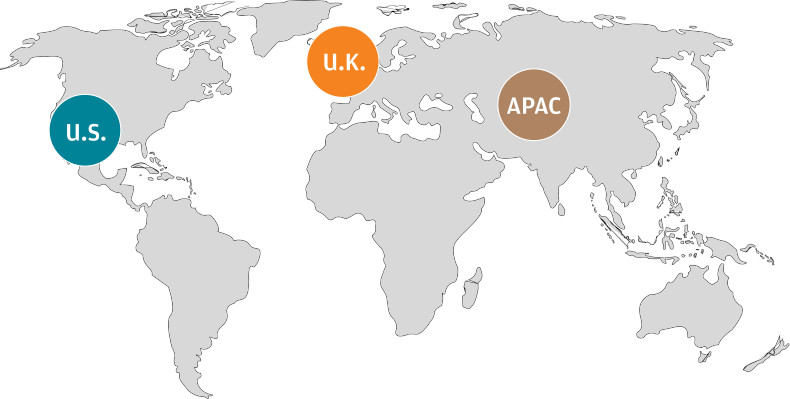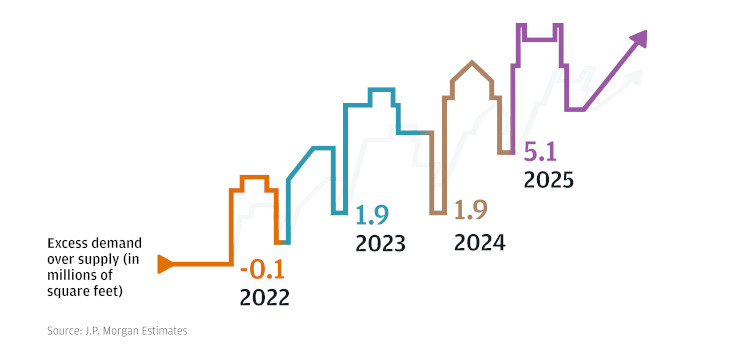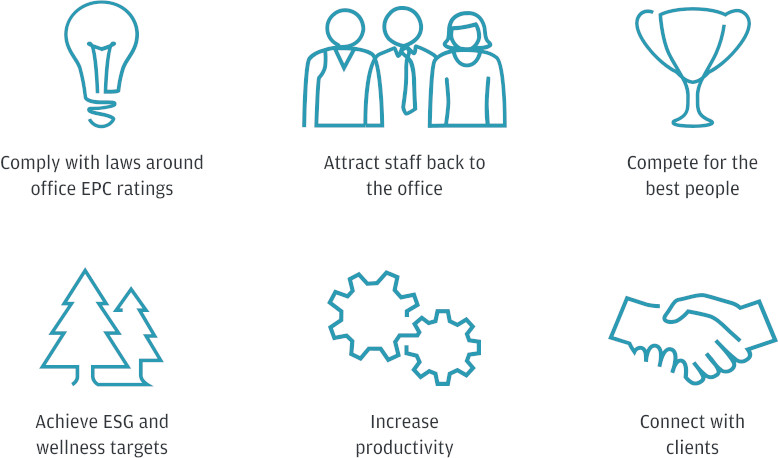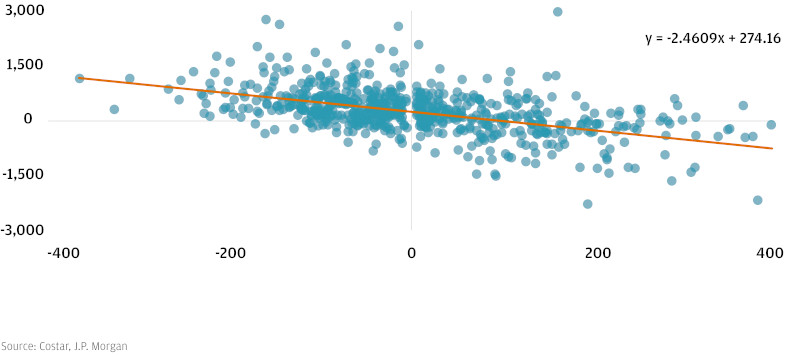We would like to thank our generous sponsors for making this article possible.
What can real estate reveal about the move to return to the office? J.P. Morgan Research explores working patterns and the future of the office post-pandemic.
Shorter office leases, the rise of flexible working spaces, employers embracing ESG values—these are just some of the structural changes taking place in global office real estate markets that align with new ways of working. But while flexible working is on the rise, a post-pandemic return to the office is in full swing across many major business locations, with growing demand for prime space in particular.
In this commercial real estate spotlight, J.P. Morgan Research looks into the post-pandemic push to return to the office, delving into the market to uncover key trends and sharing forecasts up to 2030.
The mass return to the office: Fact or fiction?
As the world moves on from COVID-19, working life has returned to many of the pre-pandemic norms. Are work-from-home patterns sticking or has the mass return to the office prevailed?

U.S.
- The office isn’t dead, but the sector is challenged
- COVID-19 has accelerated flexible working
- Lease economics might suffer, especially outside of prime locations
U.K.
- High demand for office space
- Quality offices highly sought after
- Next to no office availability in some parts of London
APAC
- Rental growth expected with Hong Kong tenant shifts and limited office supply
- Healthy demand for office space in Singapore
- Office occupancy is lower in the technology sector
Flexible and hybrid working patterns may be reducing demand for overall office space. But in London, increasing demand for prime office space outweighs this. The Deloitte London Offices Crane Survey from summer 2022 found great optimism in the office sector, pointing towards an increasing supply shortage through to 2025. J.P. Morgan Research predicts an unprecedented office supply crunch where demand will be 1.8 times higher than supply.
There is an unprecedented supply crunch forming in the London office sector towards 2025, which in our view will support and drive rental growth.
Tim Leckie
Head of European Listed Property, J.P. Morgan
“There is next to no space available in some parts of London,” said Tim Leckie, Head of J.P. Morgan’s European Listed Property Team. “There is an unprecedented supply crunch forming in the London office sector towards 2025, which in our view will support and drive rental growth. Looking ahead to 2030, we see active demand for prime office space growing by 38%.”
The demand for office space is not limited to the capital. Outside of London, office take-up almost doubled in Newcastle during the first half of 2022 compared to the same period in 2021. Initial data from BNP Paribas Real Estate revealed that Newcastle city center take-up is on course to pass the typical 10-year average.
In the U.S., return to the office dynamics are a little more challenged. “Looking ahead, we are not in the “office is dead” camp, but we think cash flow growth will be challenged in the office sector,” said Anthony Paolone, Senior Analyst and Co-Head of U.S. Real Estate Stock Research.
“The office business was challenged for many landlords before the COVID-19 pandemic, except for those already following a clear growth path. The pandemic has accelerated trends like the migration of certain jobs to other markets, more flexibility in work locations and the environmental impact of the space being used. If a building is not in the right location, lease economics may suffer for some time to come, in our view.”
We are not in the “office is dead” camp, but we think cash flow growth will be challenged in the office sector.
Anthony Paolone
Senior Analyst and Co-Head of U.S. Real Estate Stock Research, J.P. Morgan
In the Asia Pacific (APAC) region, high rental growth and reversion are expected on the back of Hong Kong tenant shifts and limited office supply. In Singapore, there is healthy demand for office space and tenants have largely returned to office. For Singapore office real estate investment trusts (REITs), physical occupancy has reached 75% in downtown central business districts (CBD). However, lower office occupancy of around 50% is being seen in the technology sector.
What’s driving office demand?
The trends driving London office demand higher are structural and changes are already well underway. The annual addressable market (defined as any tenant with a lease expiry in that calendar year) is increasing as lease lengths get shorter, which has been happening for several years now. According to J.P. Morgan Research, 14 million square feet of offices have an expiring lease, which is equivalent to the space inside The Gherkin multiplied by 27—that’s a 38% increase on 2020.

Tenants faced with expiring leases are expected to make the move to prime offices, pushing up demand where space is already at a premium. Central London take up (or relocations) averaged 12.1 million square feet per annum over the last ten years, and this is set to increase.
Estimated demand for prime office space

Why is there such high demand at the top end of London’s office market? Tenants are targeting prime space to comply with new EPC rating laws, attract staff back to the office, compete for the best people, achieve ESG and wellness targets, increase productivity and connect with clients.
Why are tenants choosing prime office space?

By 2027, office space with an Energy Performance Certificate (EPC) rating of D or worse will face re-leasing restrictions. By 2030, these restrictions will also apply to spaces with a rating of C or worse. 57% of London office space has an EPC rating of D or worse and 80% has a rating of C or worse; this means 26.8 million square feet of office space will face future restrictions. Active demand for office space could double, with the majority concentrated on new or refurbished spaces. Importantly, this increase is predicted without any job growth or reliance on the economic cycle.
There is broad demand for office space from tech, agile operators, family offices, financial institutions and consumer products. While there has been some slowdown in tech hiring, this has not adversely impacted office take-up just yet.
Mervin Song
Head of Singapore Property Research, J.P. Morgan
In Singapore, the office sector is experiencing healthy levels of demand driven by the fact that tenants have largely returned to the office. Again, ESG factors are playing a part in demand and grade A office rents—the newest, highest-quality spaces available—are most sought after, meaning some tenants need to switch to grade B. “There is broad demand from tech, agile operators, family offices, financial institutions and consumer products,” said Mervin Song, Head of Singapore Property Research. “While there has been some slowdown in tech hiring, this has not adversely impacted office take-up just yet.” Other companies are expanding, restoring the balance—one example is Amazon’s expansionary 0.4 million square foot lease in IOI Central Boulevard, just minutes away from the company’s three floors of office space in Asia Square which it took on in 2021.
There remains a lot of runway for office utilization to improve in the U.S., but there is likely to be some shedding of space given changing work patterns. J.P. Morgan Research views this as a headwind for lease rates and landlord cash flows. “Within our office REIT coverage universe, occupancy came down around 3-4% with face rents down in the high-single-digit range,” said Paolone. “Leasing decisions are starting to be made again, which should give landlords an opportunity to try to re-fill buildings, but the macro-economic environment has to be watched because office demand is cyclical. It will remain tough for office landlords.
What does the workplace of the future look like?
How is the workplace changing? Has COVID-19 left its mark on the sector? This is what the workplace of the future will look like as office space undergoes a major rethink.

Flexible Workspaces
Space is being used differently; in the U.S. and London, the COVID-19 pandemic brought about more flexibility. Flexible workspace—which offers shorter lease lengths and can include serviced offices, managed offices, shared offices and coworking spaces—is taking an increasing share of the London market, up from 6% in 2020 to an expected 30% in 2030.
While working patterns are changing, this is not necessarily leading to fundamental change. In Singapore, workplace mobility—where workforces operate interchangeably in and out of the office—is at 92% of pre-COVID levels. However, there has been limited impact on the office sector from hybrid work arrangements.
High-quality workspace
The ESG factor is becoming increasingly important. ESG is now a major consideration for tenants when they are selecting space in the U.S. This is likely to have ramifications for the sector, as office buildings produce substantial carbon emissions—efficiency is critical to attracting tenants. In the London office sector, businesses are looking to prime office space to attract workers back and meet new, more stringent regulations around EPC ratings. In Singapore, rental of grade A office spaces has led the recovery of healthy tenant demand, notably from technology and financial institutions, as the economy has reopened after COVID-19 lockdowns.
Fluctuating rent
Grade A office rents in Singapore are expected to rise 9% in 2022 and 5% in 2023, underpinned by healthy tenant demand and limited supply.
London office rents are expected to grow by more than 6% for the highest quality spaces.
In the U.S., face rents—the base rental rates paid without any incentives—were down in the high-single-digit range during the 18 months leading up to December 2021. Data shows that rent is closely tied to vacancy level, and occupancy during the same period was down around 3-4%. Even small changes in vacancy have a big impact on rent, with around a 2-3% rent change for every point change in national vacancy.
National year-over-year change in vacancy vs. rent

The office remains, but workplaces will embrace a new normal
Globally, the office sector is going through a period of change exacerbated by COVID-19 lockdowns, law changes, flexible working and structural factors. While physical office spaces and ways of working are changing and demand fluctuates between locations, one thing is clear: many workers have returned to the office, at least for part of the working week, and the workplace lives on.
Originally published at: J.P. Morgan










